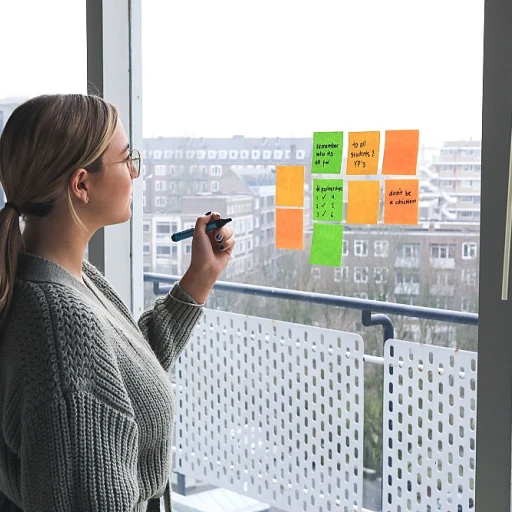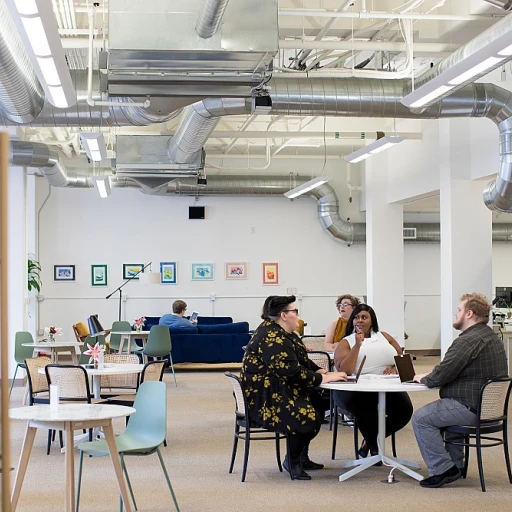The Rise of Hybrid Work Models
The Evolution of Work Environments
In today’s dynamic professional landscape, the concept of hybrid work models is dramatically reshaping how organizations operate. As companies navigate the complex post-pandemic era, a flexible work environment has become more than just a trend—it's evolving into the norm. The traditional boundary between in-office and remote work is blurring, giving rise to a flexible approach that caters to both the needs of the business and the personal preferences of employees.
Embracing hybrid work models allows organizations to tap into a broader talent pool globally. It addresses the growing demand from employees for a better work-life balance, while also leading to increased productivity and satisfaction. However, it’s crucial to understand that these new work environments require a well-thought-out framework to be successful. This involves redefining collaboration, communication, and autonomy amongst teams to maintain departmental cohesiveness regardless of physical presence.
Moreover, the shift towards hybrid models necessitates a deeper understanding of the difference between employee experience and employee engagement. These two concepts, although intertwined, focus on distinct aspects of work-life. Organizations must acknowledge this differentiation to enhance employee satisfaction and retention. For a comprehensive guide on this entire framework, delve into understanding the difference between employee experience and employee engagement.
As companies continue to integrate hybrid work models, it becomes apparent that maintaining their vibrant organizational culture is critical. This shift not only has implications for where work is conducted but how employees feel connected and engaged within their roles, and ultimately, how invested they are in the organization’s mission and values.
Prioritizing Mental Health in the Workplace
Fostering a Healthier Work Environment
In recent times, mental health has emerged as a cornerstone for thriving workplaces. Today, organizations are increasingly aware of the importance of supporting their employees' mental well-being, understanding that a stressed or burnt-out workforce can undermine overall productivity and satisfaction.
Companies are introducing initiatives ranging from flexible working hours to mental health days, ensuring that their teams can maintain a balanced life both at work and home. The shift towards prioritizing mental health support within the workplace also involves providing employees with access to counseling and wellness programs, creating safe spaces where they can voice their concerns and seek help without stigma.
These initiatives are not only feel-good measures; they are strategic moves that can lead to a more engaged and resilient workforce, which ultimately leads to an enhancement in employee retention. With organizations taking mental health seriously, employees feel valued, appreciated, and are more likely to stay loyal to the company long-term. For comprehensive strategies on boosting employee experiences to retain top talent, consider exploring more insights on improving employee engagement and retention strategies
here.
The Role of Continuous Learning and Development
Embracing a Culture of Continuous Learning
In today's rapidly evolving business landscape, companies are beginning to recognize the importance of fostering a culture that prioritizes continuous learning and development. With the rise of hybrid work models and the emphasis on mental health (as discussed in previous sections), organizations are seeing the value in equipping their employees with the tools and skills needed to adapt and thrive in this dynamic environment.
Providing opportunities for continuous learning not only enhances employee skills and capabilities but also contributes significantly to their overall job satisfaction and retention. Employees appreciate environments that encourage professional growth, which fosters a sense of belonging and engagement within the company.
One of the key aspects of nurturing continuous learning is to offer a variety of development programs that cater to diverse learning preferences. From online courses and workshops to mentorship and cross-training opportunities, the aim is to create an inclusive learning ecosystem that supports employees at every stage of their career journey.
Moreover, integrating feedback mechanisms can help to identify learning gaps and tailor programs to meet employee needs effectively. Through targeted learning initiatives, companies can empower their workforce, which ultimately leads to a more agile and resilient organization.
To understand why
employee experience matters more than ever, nurturing continuous learning should not be overlooked. By investing in personal and professional development, businesses can harness the full potential of their talent, leading to greater innovation and success.
Leveraging Employee Feedback for Better Experiences
Embracing Feedback for an Enriched Employee Journey
In the evolving landscape of employee experience, the significance of actively listening to employee feedback cannot be overstated. As organizations strive to keep up with rising trends such as hybrid work models and prioritizing mental health, incorporating employee insights becomes a pivotal strategy for crafting an environment where individuals feel valued and heard.
Gone are the days when annual surveys were the only channel for employees to voice their concerns. Today, an ongoing dialogue between employees and leadership is essential to promptly address issues and enhance workplace satisfaction. This approach not only fosters trust but also leads to more personalized and meaningful engagements.
To truly leverage feedback for better experiences, organizations need to implement robust feedback mechanisms that serve as a channel for continuous improvement. For instance, real-time feedback tools and pulse surveys allow companies to swiftly capture employee sentiments and adapt policies accordingly.
Furthermore, it is crucial for leadership to visibly act on the feedback received. When employees see that their input leads to tangible changes, it reinforces their sense of belonging and helps in nurturing a positive organizational culture. Ensuring employees feel empowered to share their thoughts contributes to a dynamic and resilient work environment where both individuals and businesses thrive.
Ultimately, embracing employee feedback as a cornerstone of your strategy not only helps in refining the current employee experience but also sets the stage for further innovations in creating a supportive and engaging workplace.
Enhancing Employee Autonomy and Empowerment
Embracing Responsibility Through Increased Autonomy
As businesses evolve, so too do their approaches to employee empowerment. Today's workplace is witnessing a substantial shift toward granting employees more autonomy—a trend that significantly enriches the overall employee experience. This movement is not merely about giving workers the freedom to choose their projects or manage their own schedules. It fundamentally aims to foster a sense of ownership and responsibility, which in turn can lead to higher job satisfaction and productivity.
Autonomy in the workplace empowers employees to bring their unique perspectives and creativity to the table. By enabling them to participate more actively in decision-making processes, organizations nurture an environment of trust and engagement. When employees feel that their contributions are valued and see their ideas being implemented, it boosts morale and cultivates loyalty toward the organization.
Moreover, increasing employee autonomy goes hand in hand with the hybrid work models that have emerged strongly. With remote work becoming a permanent fixture for many companies, allowing employees to manage their time and outputs independently has become increasingly important. The flexibility to balance personal and professional commitments can significantly reduce stress levels, contributing positively to mental health.
However, it's crucial for organizations to find the right balance. While autonomy is key, it must come with clear guidelines and support systems to ensure employees feel secure and aligned with the company’s goals. Providing tools and resources, along with continuous learning opportunities, reinforces this autonomy and encourages employees to take educated risks without fear of punitive measures.
By consciously implementing strategies to boost employee autonomy, companies can create a work environment where innovation and satisfaction thrive, ultimately leading to a more fulfilling employee experience.
The Impact of Organizational Culture on Employee Experience
Organizational Culture: The Backbone of Employee Experience
In the journey towards crafting a phenomenal employee experience, organizational culture stands as a pivotal element, shaping the daily experiences of all who walk through the doors of an enterprise. More than just policies or workplace aesthetics, a company's culture influences how employees perceive their work environment, affecting satisfaction, engagement, and productivity.
A multidisciplinary approach to employee experience, where hybrid work models and employee autonomy coexist (as previously discussed), underscores the necessity for a flexible cultural framework. Organizations embracing this can often adapt more seamlessly to changes, ensuring that employees feel part of a progressive and supportive environment.
An inclusive and positive culture also champions the importance of mental health in the workplace by fostering an environment where employees feel safe to express concerns and seek support. When mental health is prioritized, it creates a ripple effect, enhancing employee well-being and, by extension, their productivity and engagement.
Moreover, a culture that values continuous learning and development signifies an organization's commitment towards growth not only at an operational level but also at an individual level. This dedication becomes evident in how feedback is solicited and acted upon, as a culture that encourages open communication is vital for both personal and organizational improvement.
In essence, it's the intertwining of these cultural elements that magnifies the impact of an organization's ethos on its employee experience. Establishing and nurturing such a culture can be the defining difference in attracting and retaining talent, setting your organization apart as a desirable place to work.








